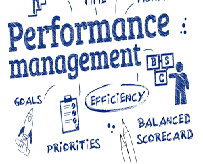Performance Management in an Organisation Order Instructions: In a successful organization, do individual employees’ performance objectives align with their organization’s strategic goals – and if so, how?

How do organizations best communicate with employees about their individual performance objectives?
In this Key Concept Exercise, you will examine the role of individual performance objectives in performance management, as well as approaches to establishing and communicating with staff about these objectives.
Prepare a 550-word analysis of the role of individual performance objectives in performance planning, and critically evaluate two approaches to setting and communicating with staff about performance objectives.
What are the strengths and weaknesses of each approach?
In which situations would one approach work better than the other?
Performance Management in an Organisation Sample Answer
Introduction
Performance improvement and the roles of the performance management are essential elements in many organizations today. The rise of business pressures in several firms has immensely taken a rise, a factor that requires the development of an effective and efficient business approach that enables an organization to be competitive. This, therefore, requires that the human resource professionals are well vast with the understanding of the essence of optimal performance management in addressing the internal obstacles that organizations undergo (Aguinis, 2012). This paper, therefore, seeks to determine how the performance of employees aligns with the strategic goals of an organization and the manner in which this occurs. The paper will also review approaches that organizations employ in communicating efficiently with their employees on their individual performance goals.
Employees’ Performance Objectives and how they align with Organization’s Goals
Performance management involves the approaches that managers employ in guiding and motivating high-performance levels in organizations. According to Aguinis (2012) such approaches involve a traditional initiative that focuses on the provision of formal performance rewards, appraisals, and recognition to spur the manner in which employees carry out their functions ( p 12). In this case, the performance objectives of individual employees can align with the goals of an organization through well-defined and set goals that remain the primary performance management activity.
In this case, the individual employee performance objectives are developed in accordance to the overall goals of an organization which defines the direction that should be followed and provides the approaches required in achieving such performances (Aguinis, 2012). It is in this event essential to determine that best practices within an organization infer to the fact that effective performance systems are tied to the objectives of an organization. This clearly means that there is an effect between individual goals and those of an organization.
The goals of an organization in this case provide an effective approach that ensures the employees of an organization are directed in supporting the overall business strategy of an organization, a factor that requires each and every individual to set goals that can be achieved and that are in line with those of the organization (Aguinis, 2012). According to sources, in order to set up effective goals that guide the performance of an organization, there is a need to determine the key areas of performance indicators the need to be defined.
In this, the key result areas infer to the aspects of the roles in which the employees are responsible such us the preparations of production schedules (Armstrong, 2014). These indicators, therefore, determine how performance within different areas may be measured for instance the units produced or the number of calls attended to in a period of time and which should require the commitment of the employees and the organizations leaders.
Communications Approaches with Employees on Performance Objectives
It is essential to also consider the fact that communication remains an essential element in enlightening the employees of an organization of their individual performance objectives. Communication can, therefore, be either upward or downward. The downward communication approach is from the management to the lower level and ensures that a judgment is passed on their performance objectives and how they can achieve these functions (Becom, & Insler, 2013).
As the information flows downward, it turns out to be individualized. On the other hand, the upward approach of communication is from the lower to the higher levels in which the employees pass on their needs, goals and aspirations. In the upwards approach, information, turns out to be precise and brief as a result of the channels passed through.
Performance Management in an Organisation Conclusion
Performance improvement and the roles of the performance management are essential elements in many organizations today. It is essential to determine that performance management involves the approaches that managers employ in guiding and motivating high-performance levels in organizations (Heslin, Carson, & VandeWalle, 2009). In this case, the individual employee performance objectives are developed in accordance to the overall goals of an organization which defines the direction that should be followed and provides the approaches required in achieving such performances.
Performance Management in an Organisation References
Aguinis, H. (2012) Performance management, 3rd ed. Upper Saddle River, NJ: Pearson Prentice Hall.
Armstrong, A. (2014) Armstrong’s handbook of performance management: an evidence-based Guide to delivering high performance, 5th ed. London: Kogan Page
Becom, A. & Insler, D. (2013) ‘Performance management: a bad process or a broken promise’, People and Strategy, 36 (2), pp.42-45.
Heslin, P.A., Carson, J.B. & VandeWalle, D. (2009) ‘Practical applications of goal-setting theory to performance management’, In: Smither, J. & London, M. (Ed.) Performance management: putting research into action. San Francisco: Pfeiffer, pp.89-114.




